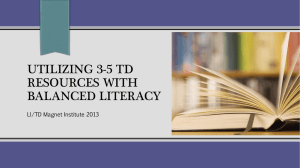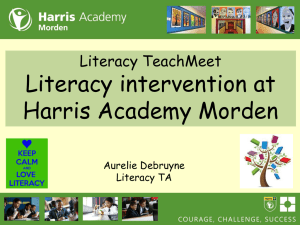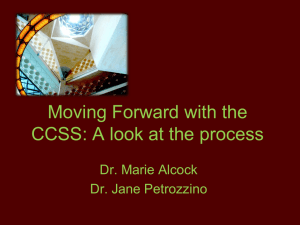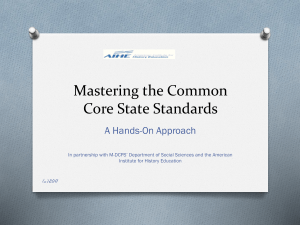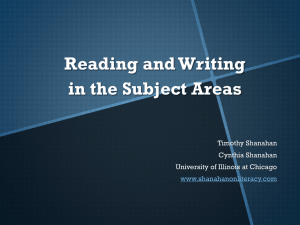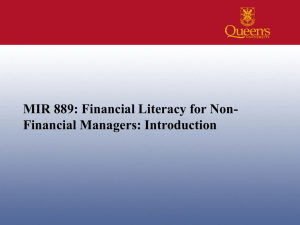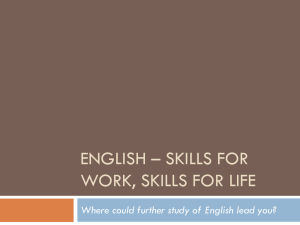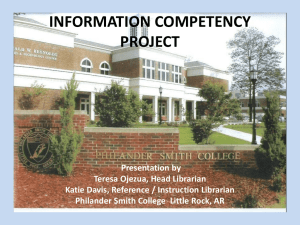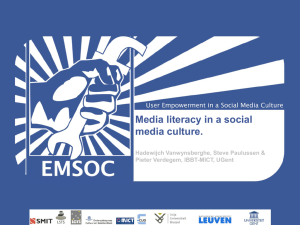585_week3 - School of Communication and Information
advertisement
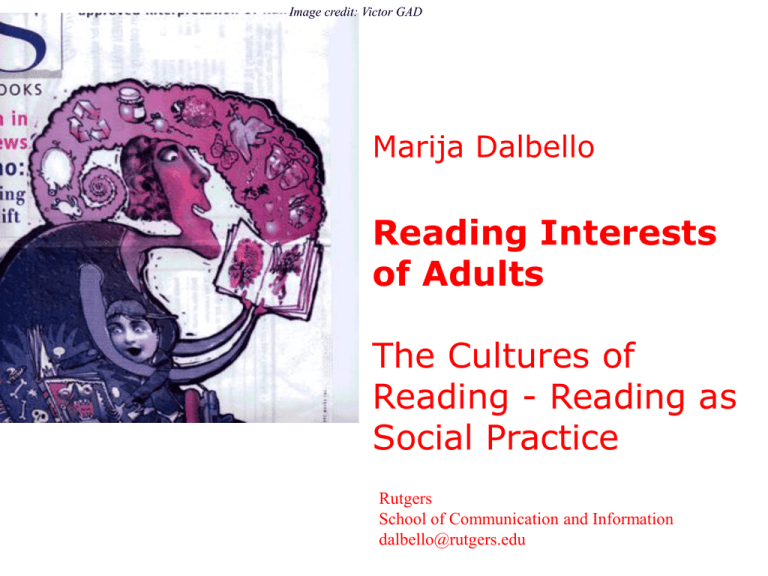
Image credit: Victor GAD Marija Dalbello Reading Interests of Adults The Cultures of Reading - Reading as Social Practice Rutgers School of Communication and Information dalbello@rutgers.edu Overview _______________________________________ Introduction Topics in reading history Reading and Readers: A historical overview Conceptual framework and studies of reading and readers A History of Reading revisited (central questions and concerns) And, how it all fits together (reading, literacy, genre in context) Introduction _______________________________________ A History of Reading - a combination of personal narrative of reading and historical scholarship on reading and readers Perspectives in the history of reading utility and purpose, materiality, general context Topics in the history of reading silent reading, history of punctuation, book forms, gendered reading, media transitions and technologies Other histories of reading R. Chartier & G. Cavallo, A History of Reading in the West L. Febvre & H. Martin, The Coming of the Book D. Finkelstein & A. McCleery, An Introduction to Book History Professional reader consults many texts Introduction _______________________________________ A History of Reading - a combination of personal narrative of reading and historical scholarship on reading and readers Perspectives in the history of reading utility and purpose, materiality, general context Topics in the history of reading silent reading, history of punctuation, book forms, gendered reading, media transitions and technologies Other histories of reading R. Chartier & G. Cavallo, A History of Reading in the West L. Febvre & H. Martin, The Coming of the Book D. Finkelstein & A. McCleery, An Introduction to Book History The History of Reading: Beginnings _______________________________________ History of materials to encode information documents & documentary practices Records of ownership, transactions of everyday life, official records Historical types: Sumerian seals, clay tablets, Greek vases, Roman public inscriptions Writing materials: parchment, papyrus rolls, codex, stone Cultures of production, circulation, use of texts, reading ecclesiastical - secular domains Historical descriptions of reading e.g., St. Ambrose (4th century CE century silent reader) The History of Reading: The Middle Ages _______________________________________ The rise of silent reading (P. Saenger) Clergy: elite literacy, control of texts in scribal culture Universities: pecia system, memorization Merchant classes: the rise of popular literacy merchant classes (12th-14th century development) Recreational reading for pleasure / reading divine texts distinction Censorship The History of Reading: Early Modern (15th-17th century) _______________________________________ Printing shapes the cultures of reading Humanist education and secular texts, science Censorship and control of output of the printing presses Displacement of Latin - rise of vernacular literacy and texts The displacement of the authority of the Church - Reformation The History of Reading: The Rise of the Novel (18th century) _______________________________________ Expanding scale production, consumption Reading becomes a necessity of life Utilitarian reading - reading for pleasure Encyclopaedias, compendia, novels, pornography Literacy becomes accessible to different classes of people From intensive reading to extensive reading (Rolf Engelsing) The History of Reading: The Age of Reading (19th century) _______________________________________ Reading in the modern sense Mass audiences and industrial production The (material and institutional) artifacts of the “long 19th century” What really happened? see next three slides … The Age of Reading: 19th century literacy revolution Reading in the Conditions of the Industrial Revolution Beginning of the century: Demand for reading is higher than the availability of material Technology of production addressing the needs created by the social movements and the new needs of being informed 1820 & 1830s: quantitative and qualitative changes visible in book and newspaper production 1830 & 1850: substantial increase in numbers of titles produced, and the dramatic decrease in the average price of those titles annually Combined effect of social changes and the technology of production creation of the mass reading public homogenization of audiences availability of reading material and ability to circulate it widely proliferation of illustrated print innovations in the nature and the feel of the printed product The Age of Reading: 19th century literacy revolution The Reading Nation Emerges • Wide-spread application of steam power to newspaper (from 1814) and book (from 1820s) production • More extensive use of stereotyping, the extended use of woodengraving (particularly in newspapers) • By the 1840s the machine production of paper (which had begun in the first decade of the nineteenth century) was becoming a significant factor • Railway system came into existence between 1830 and 1850 (UK) tremendous impact on the distribution of printed material and the circumstances in which that material was read (railway novels began appearing in the 1850s) • New literate publics - literacy rates were also rising fast as the urban population increased (by 1851 more people were living in towns than in the countryside in Britain) The Age of Reading: 19th century literacy revolution Supplying the New Reading Public with Cheaper Texts • Cutting the text up into weekly or monthly parts: serialization of novels, encyclopaedias, the Bible, etc. • Offering text in the form of penny “newspapers” (which frequently were not newspapers at all as real newspapers were taxed until the end of this period) • Publishers case bindings came in the 1830s Studies: Robert Gilmore: Reading Becomes a Necessity of Life A micro-study of colonial reading in rural New England supplies the detail Patricia Anderson: The Printed Image Focus on illustrated print, such as the Penny Magazine and impact on the education of the working class in England Robert Altick: provides a general background in the U.K. The constitution of the “common reader” associated with massdissemination of print is seen in the context of the conditions of the market, the activities of agencies (such as the Tract Society) The History of Reading: The Twentieth Century and today _______________________________________ New media convergence with trade publishing Bestsellers, the paperback series The rise and decline of reading? The social nature of reading _______________________________________ Reading as a form of behavior is operating as a complex intervention in the ongoing social life of actual social subjects. (J. Radway) Interpretive communities of readers focus on shared storytelling and social interaction Interpretation at the core of reader response collective fantasies to individual responses and interpretations in the context of everyday life Horizon of expectation history of reading, reader in history, a reader’s history Theoretical approaches (text-based to reader-based) New Criticism Reader response theory (S. Fish) Reception theory (W. Iser) Studies of reading _______________________________________ Literacy studies (contexts of literacy practices, rise of the vernacular, authorship) Print culture history (reading practices affect production & distribution of texts; reading rooted in ‘print as artefactual object’) Reader-response theory (reading act as process of interpretation, reading integrated with life history) Ethnography of reading (reading as communal activity, practiced in shared institutions and shared interpretive frameworks) A History of Reading Revisited: A conclusion _______________________________________ Reading at multiple layers Texts that can be finished in the process of reading Texts that live in an unfinished state of multiple readings Multiple authorities: of the text of the author and of the reader Text - image relations and the visual - narrative play The shapes of the book Literacy and why it relates to genre _______________________________________ Literacy (physical embodiment of text + totality of social relations within which texts reside) Genre is tied to the study of complex nature of literacy and reading across time and space but narrows the notion of literacy - by localizing specific texts within historical communities Reading, literacy, genre are interconnected

